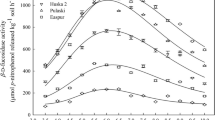Summary
Invertase (β-D-fructofuranoside fructohydrolase, EC [Enzyme Commission] 3.2.1.26) is the enzyme that catalyzes the hydrolysis of sucrose and yields glucose and fructose. The activity of this enzyme was monitored by systematically developing a sensitive and rapid method to detect reducing sugars with the precision of 1.4 to 6.1% C.V. The method involves the colorimetric determination of reducing sugars which react with 3,5-dinitrosalicylic acid when soil is incubated with buffered sucrose solution and toluene at 37°C for 24 h. The detection limit for the method described is 100 μg of reducing sugar per ml of soil extract. The color intensity remained constant up to 24 h. Comparative studies showed that the method described was in good agreement to other invertase assay procedures reported in the literature.
Studies on the stability and distribution of invertase in soils by using the method described showed that air-drying of field-moist soil samples resulted in decreased activity ranging from 15.3 to 23.7% (avg.=19.8%). Statistical analyses indicated that invertase activity was significantly correlated with total N (r=0.78***) and organic C (r=0.70***) in the topsoil of 19 diverse samples. There was no significant correlation between invertase activity and soil pH, cation exchange capacity, percentage of clay and percentage of sand. The activity of this enzyme was concentrated in surface soils and decreased with profile depth. Regression analyses showed that invertase activity was significantly correlated with organic carbon content of three soil profiles examined.
Similar content being viewed by others
References
Claus D and Mechsner K 1960 Über die Brauchbarkeit der von Ed. Hofmann ausgearbeiteten Methoden zur Bestimmung der Enzyme in Böden. Plant and Soil 12, 195–198.
Frankenberger W T Jr and Johanson J B 1982 L-Histidine ammonia-lyase activity in soils. Soil Sci. Soc. Am. J. 46, 943–948.
Frankenberger W T Jr and Johanson J B 1983 Distribution of L-histidine ammonia-lyase activity in soils. Soil Sci. 135,in press.
Frankenberger W T Jr and Tabatabai M A 1981 Fate of amide nitrogen added to soils. J. Agric. Food Chem. 29, 152–155.
Frankenberger W T Jr and Tabatabai M A 1981 Amidase activity in soils: III. Stability and distribution. Soil Sci. Soc. Am. J. 45, 333–338.
Galstyan A S 1965 A method of determining the activity of hydrolytic enzymes in soil. Pochvovedenie 2, 68–74.
Hoffmann V G and Pallauf J 1965 Eine kolorimetrische Methode zur Bestimmung der Saccharase-Aktivität von Böden. Z. Pflanzenernähr. Bodenkd. 110, 193–201.
Hofmmann E and Hoffmann G 1961 Über die Zuverlässigkeit der Methoden zur Bestimmung der Aktivität von Bodenenzymen nach Ed. Hofmann. Plant and Soil 14, 96–99.
Hofmann E and Seegerer A 1951 Über das Enzymsystem unserer Kulturböden. I. Saccharase. Biochem. Z. 322, 174–179.
Jones R J A 1972 The measurement of mean temperatures by the sucrose inversion method. Soils Fertil. 35, 615–619.
Jones R J A and Court M N 1980 The measurement of mean temperatures in plant and soil studies by the sucrose inversion method. Plant and Soil 54, 15–31.
Kuprevich V F and Shcherbakova T A 1967 Comparative enzymatic activity in diverse types of soil. pp 167–201.In Soil biochemistry. Eds. A D McLaren and J J Skujins. Vol. 1. Marcel Dekker, New York.
Nizova A A 1960 Biological activity of soils. Pochvovedenie 10, 96–101.
Pallman H, Eichenberger E, Hasler A 1940 Prinzip einer neuen Temperaturmessung für ökologische oder bodenkundliche Untersuchungen. Bodenkd. Forsch. 7, 53–71.
Peterson N V and Astaf'eva E V 1962 Methods of estimating the invertase activity of soils. Mikrobiologiya 31, 743–746.
Ross D J 1965 A seasonal study of oxygen uptake of some pasture soils and activities of enzymes hydrolysing sucrose and starch. J Soil Sci. 16, 73–85.
Ross D J 1965 Effects of air-dry, refrigerated and frozen storage on activities on enzymes hydrolysing sucrose and starch in soils. J Soil Sci. 16, 86–94.
Sumner J B and Sisler E B 1944 A simple method for blood sugar. Arch. Biochem. 4, 333–336.
Shaffer P A and Hartmann A F 1921 The idiometric determination of copper and its use in sugar analysis. II. Methods for the determination of reducing sugars in blood, urine, milk, and other solutions. J. Biol. Chem. 45, 365–390.
Skujins J J 1967 Enzymes in soil. pp 371–414.In Soil Biochemistry, Vol. I. Eds. A D McLaren and G H Peterson. Marcel Dekker, New York.
Skujins J 1978 History of abiontic soil enzyme research. p. 1–49.In Soil Enzymes. Ed. R G Burns, Academic Press, New York.
Skujins J J, Braal L, McLaren A D 1962 Characterization of phosphatase in a terrestrial soil sterilized with an electron beam. Enzymologia 25, 125–133.
Author information
Authors and Affiliations
Rights and permissions
About this article
Cite this article
Frankeberger, W.T., Johanson, J.B. Method of measuring invertase activity in soils. Plant Soil 74, 301–311 (1983). https://doi.org/10.1007/BF02181348
Received:
Revised:
Issue Date:
DOI: https://doi.org/10.1007/BF02181348




